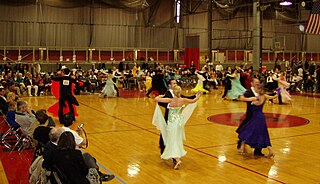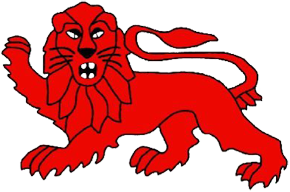
Ballroom dance is a set of European partner dances, which are enjoyed both socially and competitively around the world, mostly because of its performance and entertainment aspects. Ballroom dancing is also widely enjoyed on stage, film, and television.

Dancesport is competitive ballroom dancing, as contrasted to social or exhibition dancing. In the case of Para dancesport, at least one of the dancers is in a wheelchair.
Rivalry between the Universities of Oxford and Cambridge is a phenomenon going back many centuries. During most of that time, they were the only two universities in England and Wales, making the rivalry more intense than it is now.
Formation dance is a style of ballroom dancing. It is pattern or shadow team dancing by couples in a formation team. The choreography may be based on a particular dance or a medley of dances. Formation dancing may be done for exhibition or for competition between teams. There is also a type of formation in Bhangra.

Cambridge University Cricket Club, established in 1820, is the representative cricket club for students of the University of Cambridge. Depending on the circumstances of each individual match, the club has always been recognised as holding first-class status. The university played List A cricket in 1972 and 1974 only. It has not played top-level Twenty20 cricket.
The Inter Varsity Dance Competition (IVDC) is an annual student dancesport competition organised by Inter Varsity Dance Association (IVDA). The IVDA write rules regarding entries, dress code and which dances will be part of the competition.
A blue is an award of sporting colours earned by athletes at some universities and schools for competition at the highest level. The awarding of blues began at Oxford and Cambridge universities in England. They are now awarded at a number of other British universities and at some universities in Australia and New Zealand.

Oxford University Cycling Club (O.U.C.C.) is a cycling club for students and associated members of the University of Oxford. Via earlier incarnations, the Dark Blue Bicycle Club (D.B.B.C.) and the Oxford University Bicycle Club (O.U.Bi.C.), it has a history reaching back to the very origins of club and competitive cycling.
Swedish Dancesport Federation (DSF) administers all dancesport in Sweden. The association was formed on February 25, 1968, and is one of 68 different sports federations in Sweden. DSF became a member of the Swedish Sports Confederation (RF) in 1977, which administers all sports in Sweden. Apart from this membership Swedish Dancesport Federation also is a member of the International Dancesport Federation (IDSF) from June 19, 2011, known as the World DanceSport Federation (WDSF) and the World Rock'n'Roll Confederation (WRRC). The office lies in Farsta, Stockholm.

The 8-day Blackpool Dance Festival is the world's first and most famous annual ballroom dance competition of international significance, held in the Empress Ballroom at the Winter Gardens, Blackpool, England since 1920. It is also the largest ballroom competition: in 2013, 2953 couples from 60 countries took part in the festival.

Oxford University Handball Club (OUHaC) was founded and registered as a club at the University of Oxford in 2001 and has since established itself as one of England's most successful clubs. It is a member of the England Handball Association since 2002 and the Association of British Universities Handball Clubs since 2011. Every year, OUHaC competes in the English Handball League, EHA Cup and the British University Championships. Beginning in 2014, the club has played in the varsity match against the Cambridge University Handball Club. In 2016 and 2017 respectively, the women's and men's teams were granted Half Blue status by the Blues committees of the University of Oxford.
Oxford University Dancesport Club (OUDC) is Oxford University's largest sports club and is the second largest club at the university after the Oxford Union. Founded in 1968 it currently has an annual membership of around 800 members. It runs professionally taught classes in the following dance styles:
The Oxford University Amateur Boxing Club (OUABC) is the boxing club of the University of Oxford, England, located in Oxford. The club was founded in 1881. It is the second-oldest active amateur boxing club in the UK. Several OUABC boxers were featured in a 2006 documentary titled Blue Blood.

The English Amateur Dancesport Association (EADA) Ltd is a volunteer-led organisation which represents the interests of Amateur Dancers within England. EADA provides support and training for Amateur dancers and acts as the voice of English Amateur dancers amongst other dance organisations both in the UK and overseas. EADA also aims to get the younger audience involved and on the dance floor. EADA hopes to increase the profile of dancesport.
The University Golf Match is the annual golf match contested between the Full Blue golf teams from Oxford and Cambridge universities. Dating back to 1878, it is the oldest amateur event in golf, as the first Amateur Championship was played in 1885. It is also the oldest team event in English golf. Scottish team matches were common after 1849, and included St Andrews University matches against Fife artisan clubs.
Cambridge University Amateur Boxing Club (CUABC) is the boxing club of the University of Cambridge, England. The club was founded in 1896 after the King's College Boxing Club amalgamated with Fordham's School of Arms to form the Cambridge University Boxing & Fencing Club (CUB&FC).
"Vivat Russia!" International Open DanceSport Tournament is a dancesport tournament held on annual basis in Krasnodar region. Starting from 2007 the tournament is recognized as an international one being held in Adler, from 2009 on the tournament has been held in Sochi. The contest consists of two syllabi: Standard and Latin. Dancers that chose the first syllabus must base their routines on Waltz, Tango, Viennese Waltz, Slow Foxtrot and Quickstep. Dancers that chose the Latina syllabus must base their routines on such dances as Latina, Samba, Cha-Cha-Cha, Rumba, Paso Doble and Jive. "Vivat Russia!" is a traditional tournament of the World DanceSport Federation (WDSF). Each participant of the tournament receives rating points and takes his or her position in the world ratings based on the rank achieved. International status is the highest status available, thus couples competing at "Vivat Russia!" Tournament may potentially receive maximum possible number of points.

The Oxford University Polo Club is the Discretionary Full Blue sports club for competitive polo at Oxford University. Founded in 1874, it is one of the four oldest continuing polo clubs worldwide. Its annual Varsity Match against Cambridge University Polo Club, established in 1878, is the second oldest continuing polo fixture in the Western world. It is played at Guards Polo Club, England, usually at the beginning of June.

The Varsity Polo Match is an annual polo match between the Oxford University Polo Club and the Cambridge University Polo Club, played between teams of four players. Historically it was known as the inter-University Challenge Cup or inter-Varsity polo match. It is also known as the Oxford-Cambridge Polo Match or by a title that includes the name of its current sponsor. Members of both teams are traditionally known as Blues, with Oxford in dark blue and Cambridge in light blue.

Oxford University Women’s Association Football Club is an English football club representing the University of Oxford. The club consists of two squads, the Blues and the Furies. Both teams compete in the BUCS League against other British universities. The Blues won BUCS Midlands Division 2A in the 2013/2014 season, gaining them promotion into Midlands Division 1A. The Blues have retained their place in this league for the 2016/17 season. The Furies won the Midlands 3A league in 2015/16, gaining promotion to the 2A division.











